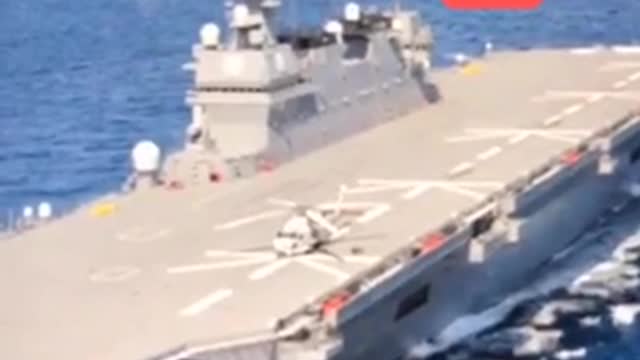Premium Only Content

How Powerful Is The Japanese Army Strenght
This video is about Japan’s increasing military power particularly its increasing offensive capabilities due to fears of China’s growing assertiveness, North Korea’s ballistic missile tests, and Russian deployment of missiles and naval forces near disputed islands. Japan is calibrating it’s traditionally pacifist defense policy towards a more offensive one in response to these growing threats. Today, Japanese military power is ranked fifth in the world after the United States, Russia, China, and India, and its defense budget is ranked sixth in the global ranking. Presently, the JSDF has almost 250,000 active military personnel, more than 900 warplanes, 48 destroyers including eight Aegis missile-combating systems, and 20 submarines. That exceeds Britain, Germany and Italy. Japan is also buying 147 F-35s including 42 F-35Bs, which will make it the largest user of American stealth fighters outside of the United States. The country is now retrofitting two flattops including the Izumo and Kaga as the country's first aircraft carriers since the end of the World War II. Today, Japan is a major ally of the United States and could be a crucial partner in a war against the People's Republic of China, Russia or North Korea.
Japan has rapidly stepped up its military role in its alliance with Washington, and has made more purchases of costly American weapons and equipment, including fighter jets and missile interceptors. Japan hosts around 50,000 American troops, principally on the southern island of Okinawa, who, along with Japanese units in Hokkaido, are strategically important to the US presence in the Pacific. Japan has expanded military partnerships and joint exercises beyond its alliance with the United States, including with Australia, Canada, the United Kingdom, France, and other European countries, as well as in the Association of Southeast Asian Nations, in part due to the relative decline of America's global influence.
Japan works with NATO as well. There are multiple growing challenges and threats that Tokyois facing today. One amongst these threats is China. China and Japan have territorial disputes over the Japanese controlled Diaoyu Islands which are called the Senkaku Islands by the Japanese. Both China and Japan have ramped up coastguard patrols near the disputed islands in recent years. Among Japan's biggest worries is China's increased naval activity, including aircraft carriers that have been repeatedly spotted off Japan's southern coasts.
Japan has also an ongoing dispute with Russia over the Kuril Islands which the Soviet Union seized at the end of the Second World War. Russia's military has recently deployed Bastion coastal defense missile system near disputed islands off the northern coast of Hokkaido. Meanwhile, China and Russia have also stepped up military cooperation in recent years in an attempt to counter growing U.S.led regional partnerships. Last year, a fleet of five warships each from China and Russia circled Japan as they traveled through the Pacific to the East China Sea. Later, their warplanes flew together near Japan's airspace, causing Japanese fighter jets to scramble. Since 2021, Japanese fighters have scrambled more than 700 times against Russia and China.
Another front for Japan to defend against is North Korea. Recently, North Korea test-fired an intercontinental ballistic missile for the first time since November 2017.
To counter these threats to Japan, the responsibility lies with the Japan Self-Defense forces which consist of the Japan Ground Self-Defense Force, the Japan Maritime Self-Defense Force, and the Japan Air Self-Defense Force. These are controlled by the Ministry of Defense with the Prime Minister as commander-in-chief. Japan still sees the U.S. military playing a fundamental role in assuring Japanese security—an arrangement which suits the Pentagon as its posture in East Asia depends heavily on bases on Japanese soil.
-
 1:03:06
1:03:06
The Rubin Report
2 hours ago‘Piers Morgan’ Goes Off the Rails as 'TYT' Host Attacks Dave with Nasty Insults
29.4K71 -
 1:47:50
1:47:50
Steven Crowder
3 hours agoLWC Christmas Special 2024 | Giving Back with Santa Crowder
101K205 -
 LIVE
LIVE
The Dana Show with Dana Loesch
1 hour agoTRUMP SLAMS SPENDING DEAL | The Dana Show LIVE On Rumble!
591 watching -
 35:43
35:43
Grant Stinchfield
1 hour agoThe C.R. in One Page, Anything Longer is the Deep State Exposed
3.53K2 -
 23:06
23:06
The Shannon Joy Show
4 hours ago🔥🔥Live EXCLUSIVE W/ Patrick Wood On Drones, Bitcoin, Artificial Intelligence & The Technocracy🔥🔥
5.35K2 -
 2:19:25
2:19:25
Matt Kohrs
12 hours agoMarket Chaos || The MK Show
61.9K6 -
 32:38
32:38
Rethinking the Dollar
2 hours agoDebt Ceiling Drama: What Trump Wants Now | Morning Check-In
5.07K5 -
 2:02:10
2:02:10
LFA TV
14 hours agoDING DONG THE BILL IS DEAD! | LIVE FROM AMERICA 12.19.24 11am EST
31.7K24 -
 37:31
37:31
BonginoReport
6 hours agoShut It Down (Ep.108) - 12/19/2024
107K277 -
 LIVE
LIVE
Vigilant News Network
18 hours agoBUSTED: ‘The View’ Co-Host May Face Criminal Investigation | The Daily Dose
1,030 watching